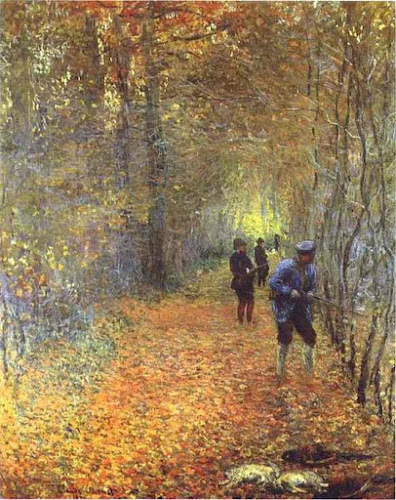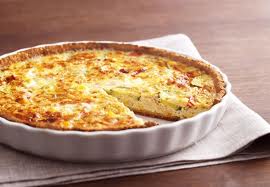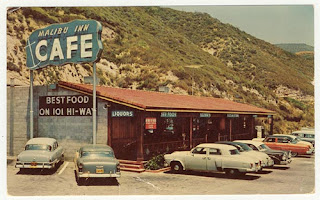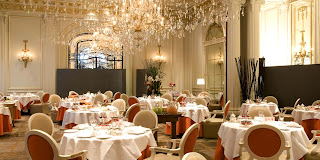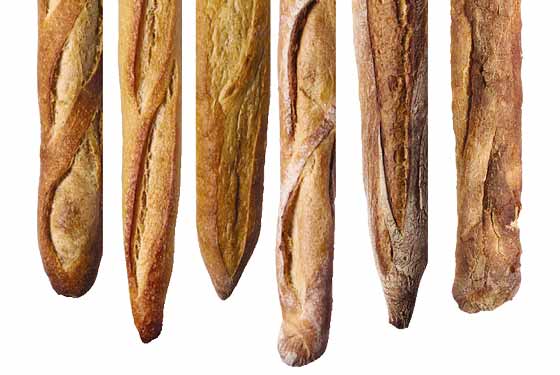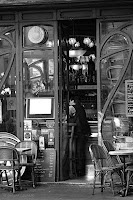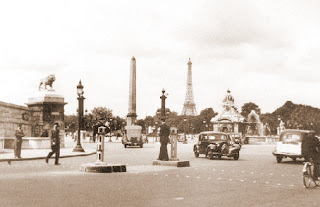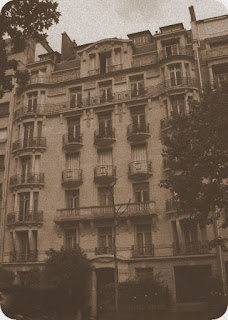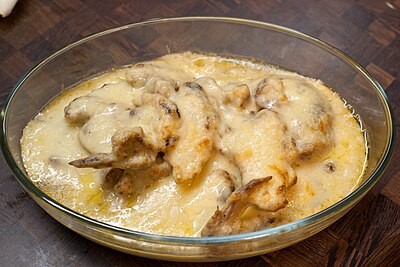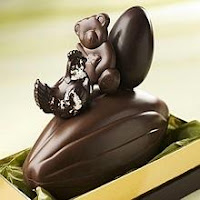In my line of work, sources are as necessary as your right arm; but good sources are jewels to be jealousl y guarded and carefully nurtured. It was suggested that I ought to take a little side trip to the 13th arrondissement, home to the quartier Butte aux Cailles with its narrow cobblestone streets, quirky restaurants, cafes and boutiques. My source led me to a restaurant on the rue des Cinq Diamants and I will tell you it is well worth poking your nose in the door and staying awhile. I suspect this little hang-out might not appeal to "le tout Paris" and for that maybe we should thank our lucky étoile because (soto voce) the prices are actually reasonable and I was able to leave with the shirt still on my back. One small detail to bring to your attention, no reservations and no credit cards. I mean like really no. Non, no, nyet, iya.
y guarded and carefully nurtured. It was suggested that I ought to take a little side trip to the 13th arrondissement, home to the quartier Butte aux Cailles with its narrow cobblestone streets, quirky restaurants, cafes and boutiques. My source led me to a restaurant on the rue des Cinq Diamants and I will tell you it is well worth poking your nose in the door and staying awhile. I suspect this little hang-out might not appeal to "le tout Paris" and for that maybe we should thank our lucky étoile because (soto voce) the prices are actually reasonable and I was able to leave with the shirt still on my back. One small detail to bring to your attention, no reservations and no credit cards. I mean like really no. Non, no, nyet, iya.
Possibly one or two loyal blog followers will surely remember my fondness for Basque cooking and this little "trouvaille" is, in my humble opinion, well worth your time or "ça vaut le coup"as they say. The menu is wonderfully slanted to French Basque and Southwest (la cuisine régionale) cooking. Imagine, if you will, giant mixed salads, Basque-style chicken, cassoulet (may I have some more please?) potatoes with ham and cantal cheese, chipiron biscaina which is whole calamari in a ratatouille-like sauce, and of course pipérade (Basque-style eggs scramble with vegetables.) Those are among the many house specialties. Stick a fork in me and call me done!
All that good food brings me to my choice of selections. Every so often I have a wild idea but usually have to lie down before it goes away. This time, wild yes, but in the sense that I depart from my traditional culinary sentier and dare to suggest something so ordinary yet so very different. I would urge you to have this as your Sunday brunch and better yet this Mother's Day - it would be a crime not to and remember mother's never ever forget! Personally speaking, on the weekends, I'm not your mister friendly in the AM and generally refuse to interact with the world by phone, emails, IM's or worse, in person until I've have several jolts of super high-test, a look at the Sunday newspaper, a healthy Bloody Mary or, after I've sabered (sabrage) a chilled champagne bottle and enjoyed a couple of delicious glasses.
In the language of the early American settlers, this little dish is going to blow your brunch socks right off. You can have it for lunch or dinner but to tell you truth, brunch just struck me as the right path to follow. I could pair this selection with one or two wines du pays but, frankly mes amis, you know deep down that only a chilled bottle of champagne could ever truly pay homage (love the word) to this quirky, funky, tasty and delicious dish. Enjoy but please be careful.
Basque-Style Scrambled Eggs
(adapted in part from The Paris Café Cookbook)
2 tomatoes, peeled and chopped (see Note 1)
2 green peppers, thinly sliced
1 red pepper, thinly sliced
a healthy dash of cayenne pepper
a healthy dash of Spanish smoky paprika (see Note 2)
1/2 cup white wine (such as Bordeaux blanc, Mâcon)
1 tablespoon sugar
1/2 teaspoon dried thyme
salt and freshly ground black pepper
1 tablespoon unsalted butter
6 slices country ham
1 tablespoon fresh parsley, chopped
1 Napoleonic saber
Preparation
First saber a bottle of chilled champagne and serve yourself, that is, if you still have a hand that's attached.
Heat the olive oil in a large saucepan over medium-high heat. Add the garlic and onions and cook, stirring, until translucent, about 8 minutes.
Add the chopped tomatoes, green and red peppers, cayenne pepper and Spanish paprika, white wine, thyme and sugar. Season with salt and pepper to taste, reduce the heat to low,and cook gently, stirring occasionally, for 35 minutes. I covered mine for a good 20 minutes first.
Heat the butter in a skillet over medium-high heat. Pour in the beaten eggs, season with salt and pepper, and stir with a fork until they are cooked through. Remove from the heat.
In a nonstick pan over medium heat, brown the ham slices lightly on both sides, about 3 minutes on each side.
To serve, combine the scrambled eggs with the pepper and onion mixture and top each serving with a slice of ham. Add parsley for garnish.
Note 1: To peel tomatoes, place in boiling water for 30 seconds, plunge into cold water, and peel with a sharp knife. Alternatively, don't. The peeled whole tomatoes in can are a fine substitute. Don't worry, they won't come and get you.
Note 2: The original recipe just called for Cayenne pepper to which I have added Spanish Paprika and for the better! However, I would have used Piment d'Espelette because that truly is the local/regional red pepper. If you don't want to buy the rather pricey Piment d' then Cayenne and Spanish Paprika gets you pretty close.
Now about that Champagne ...
Champagne Les Pionniers Brut NV, France - Young, breezy and very fresh (reminds me of someone long-ago in Paris) at a decent price – you can't ask for more than that. This is in the snappy, whistle-clean aperitif style rather than rich and food-worthy, so chill it for a spot of glass clinking with friends.
Kir Royale - Pour iced champagne or sparkling wine into a large chilled wine glass, add 1/2 ounce of crème de cassis, and stir gently. Garnish with a twist of lemon peel and toast your favorite revolution.
Asda Extra Special Vintage Champagne Brut 2002, France -The words 'Asda' and 'champagne' might not seem like traditional bedfellows even for the French, but open your mind. This is a wonderful vintage release from a good year, full of toasty, buttery richness and with a dry, satisfyingly full-flavoured finish. I served it to some friends to go with a smoked-salmon starter, and it went down like a storm. Forgot the main course but everyone was happy.
Savoy 2000(American Bar, The Savoy, London) - Take 2/3 ounce gin, 2/3 ounce Midori, 1/3 ounce Limoncello, 1-2/3 ounces mango juice. Pour into glass frosted with sugar, and top with champagne. I was first introduced to this most refreshing pause in '45 whilst at The Savoy.
Roederer Estate Anderson Valley Brut, California- Reviews say it's easy to mistake this California-made Roederer Estate NV Brut for fine French Champagne, partly because its made using techniques developed by top French producer Louis Roederer and drinking directions are in French, voila! Experts say the … expandbouquet of cherry and apple gives way to flavors of citrus and spice. 'Tis true.
Chanel No. 6 (Because a lady can never have enough Chanel nor tire of receiving it.. that's what the old man told me.) Pour 1 ounce vodka, 1 ounce Chambord, and 1 ounce chilled pineapple juice into a champagne glass. Top with well-chilled champagne. Add a fresh raspberry. This will cool her down to a working temperature.
Nicolas Feuillatte Brut NV, France
The whisper among self-proclaimed critics is that Nicolas Feuillatte Brut NV Champagne is an excellent value. Although not as refined or elegant as vintage Champagne, non-vintage Champagne really showcases a winery's house style, and costs less. Fairly light and delicate, and a great complement to party foods. You can, and should, stock up on winner for parties, unexpected guests (!?!) or for pure personal pleasure. The last has my vote.
Midnight Kiss Cocktail or The Morning After (you decide)
Rim the edge of a wine glass with white or gold sugar. Pour 3/4 oz. well-chilled vodka into the glass, and fill with champagne or sparkling wine. Top with Blue Curaçao. It was at a bar in Willemstad...that evening, how could I ever forget?
And dare I forget??
Cajun Bloody Mary (a few of these and you'll actually believe you're at Harry's Bar)
4 oz. tomato juice
1 oz. beef broth
1 tsp. whole-grain mustard
Pickled okra juice, to taste
Freshly ground black pepper, to taste
Pickled okra, pickled green beans,
and caper berries, for garnish
